How to still enjoy hearty festive meals without worrying about weight gain
You’re likely to add a few kilos of extra weight during the Christmas and New Year’s Eve period. How do you enjoy the festivities you deserve without piling on the calories? Experts lay out a few scenarios.
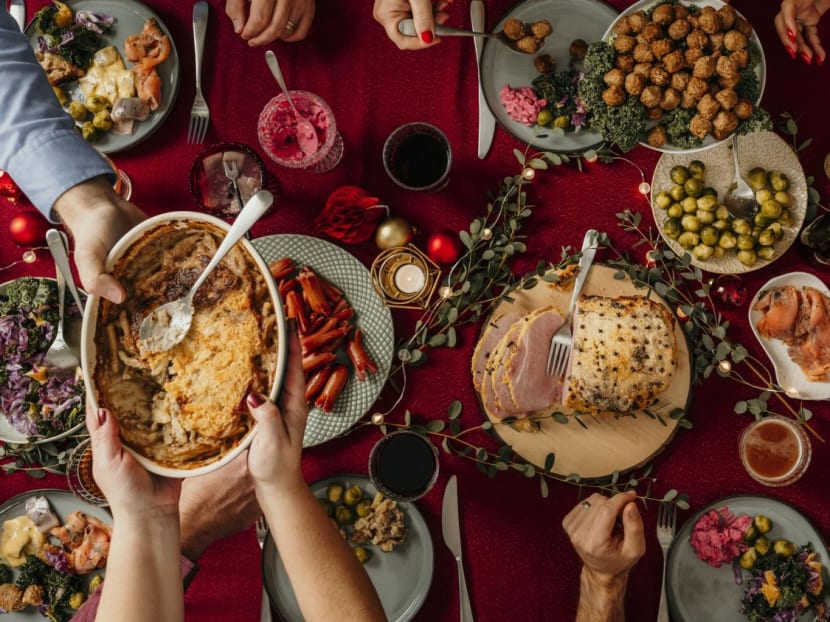
(Photo: iStock/knape)
Sometimes, despite your best efforts, you still fail to stop the number on your weighing machine from climbing. And the double whammy celebration period between Christmas and New Year’s Eve isn’t going to help – it’s when you’re likely to gain a few kilos around this time.
Case in point: A typical hearty Christmas dinner can have from 800 to 1,000 calories, said dietitian Jaclyn Reutens, who is the founder of Aptima Nutrition and Sports Consultants.
That’s from just one get-together – and doesn’t even include the liquid calories from alcohol.
That’s not to say you have to trade the Christmas honey-glazed ham for plain, steamed chicken breast, or raise a glass of cranberry juice instead of champagne to the New Year. That really wouldn’t be fair, especially when we all need some festive cheering up – if not for the body, then for the spirit.

So how do you enjoy the festive moment without packing on too much calories when the feasting begins this week?
We asked some experts to come up with a gameplan – here’s a look at some common scenarios that you’re likely to encounter and what you can do.
Happy, healthy holidays!
SCENARIO #1: GATHERING WITH BYO FOOD
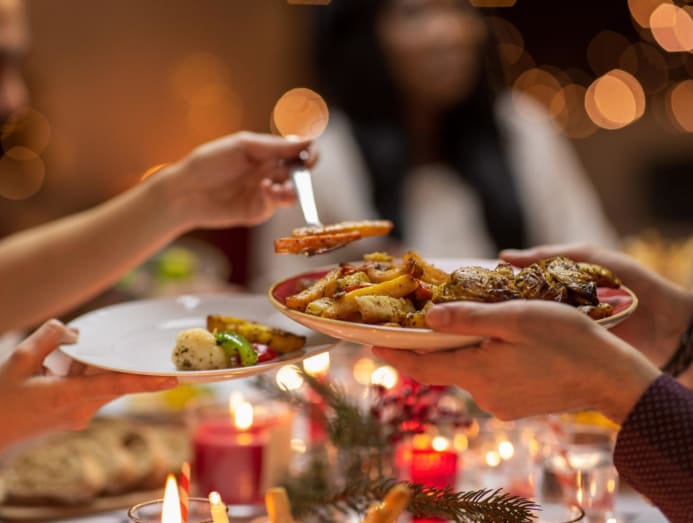
The borders are opened, the caps on social gatherings are lifted and many of us are already socialising.
As for the food, it’s a downer to be eating a salad while you see your friends chow down on roasted wagyu beef and gingerbread cookies. But you can still have your log cake and eat it, too, said Dr Chester Lan, a resident doctor at DTAP Clinic, by limiting your portions and partitioning out your food.
“For example, choose a smaller bag of chips over a larger one. If you have a big bag, pour out a serving and keep the rest out of sight,” he said. You can also keep the remaining portion with someone who can help you control your intake.
If you have the tendency to munch mindlessly during gatherings, try replacing bites of food with sips of water to reduce the calories consumed, suggested Melanie Anthonysamy, the nutrition team lead at digital health platform HealthifyMe.
“Add some Christmas colours and flavours by infusing your water with fruits such as apples, berries, passionfruit, lemon and mint,” she said.
Drinking water is also a good idea because when you are well hydrated, your body will not mix up your hunger and thirst cues, which prevents you from overeating, she added.
Another way to avoid munching mindlessly is to be more engaged in the conversation, suggested Anthonysamy. “You’d realise that you don’t really have time to munch as you are spending time processing and engaging in the conversation.”
SCENARIO #2: COOKING AND ORDERING FOOD FOR A SMALL GATHERING
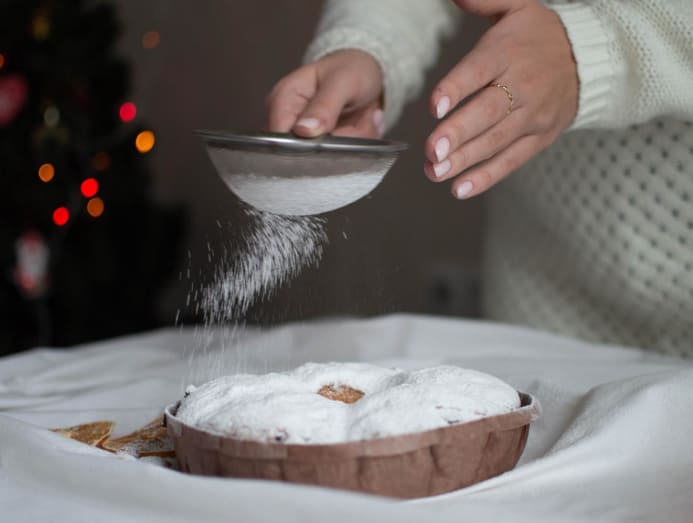
Festive dishes are aplenty and there’s a high chance you’ll end up with a table full of protein, fat and refined sugar if you’re not careful.
To get around that, omit the ham if you’re already serving turkey and roast beef to avoid putting out too much protein, advised Anthonysamy.
Wherever possible, serve unprocessed fruits and vegetables. For instance, omit fruitcake and opt for fresh fruits instead to cut down on refined sugar and fat, she said.
For a gathering of five, Anthonysamy suggested prepping the following:
- One small whole turkey
- 10 small slices of roast beef
- A big pot of roasted vegetables
- One small log cake
- Fruits
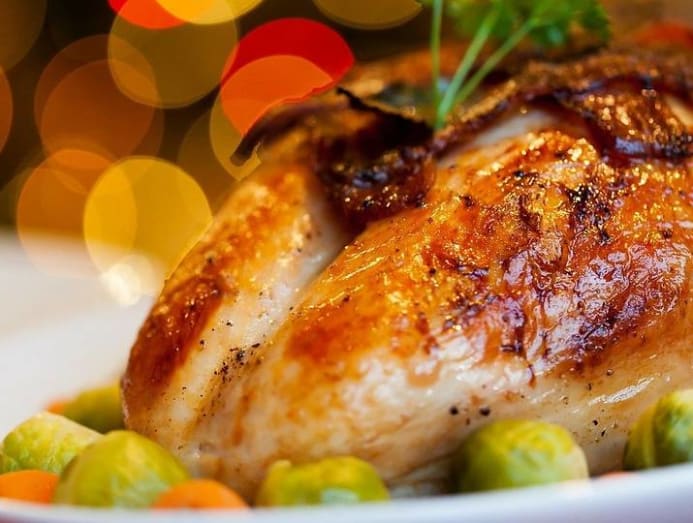
Or you can substitute the above food (just don't swap out the fruits and vegetables) with these options suggested by Reutens for a party of five:
- 500g roast beef
- 150g ham (or get the smallest leg or roll)
- 1 or 2 racks of ribs, depending on the number of ribs each rack has (3 ribs per person)
- 400g log cake
- 400g bread pudding (2 tablespoons of brandy sauce per person)
- 150g fruit cake
- 150g panettone
SCENARIO #3: TRYING OUT ASIAN-INSPIRED FESTIVE TREATS
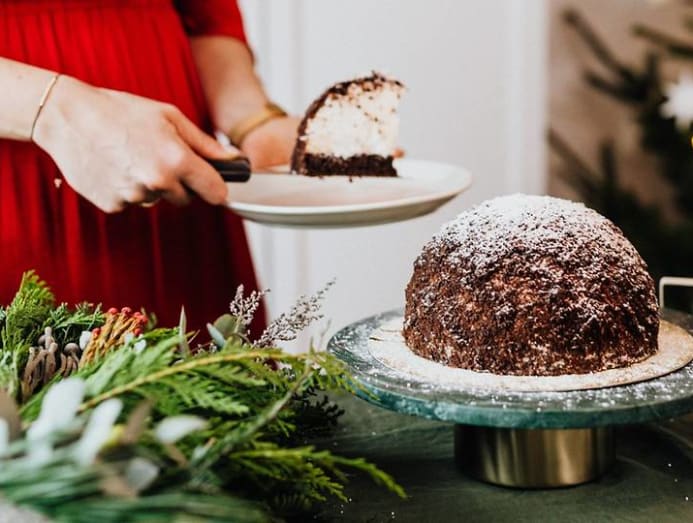
It is the time of the year when hotels, restaurants and cafes show off their culinary creativity by dressing up traditional festive treats with Asian flavours. After all, who doesn’t love the idea of a buah keluak turkey or gula melaka log cake?
But with great flavours come great calorie counts. And it can be difficult to break down the exact nutritional profiles (such as carbohydrates, protein, sugar and fat, etc) of these hybrid dishes as the recipes differ – also, we aren’t privy to them.
So, we got Reutens to provide the nutritional values of the original dishes, which can give you a rough idea of how much you’re consuming when you’re tucking into the fusion version. Here’s a look:
- Buah keluak turkey
Inspired by: Ayam buah keluak
Per 100g: 136 calories, 9g fat, 485mg sodium
- Five-spice wagyu beef
Inspired by: Five-spice pork stew
Per 100g: 144 calories, 10g fat, 1g sugar, 648mg sodium
- Char siew rack of ribs
Inspired by: Char siew pork
Per 100g: 255 calories, 12.7g fat, 6.2g sugar, 476mg sodium
- Thai-style poached salmon
Inspired by: Thai-style steamed fish
Per 100g: 111 calories, 3.3g fat, 297mg sodium
- Gula melaka log cake
Inspired by: Pandan chiffon roll
Per slice: 135 calories, 7g fat, 9.1g sugar, 74mg sodium
- Eggnog bubble milk tea
Inspired by: Bubble milk tea
Per medium cup: 335 calories, 13.6g fat, 28g sugar, 34mg sodium
SCENARIO #4: YOU CAN’T HELP BUT EAT WHAT’S IN FRONT OF YOU
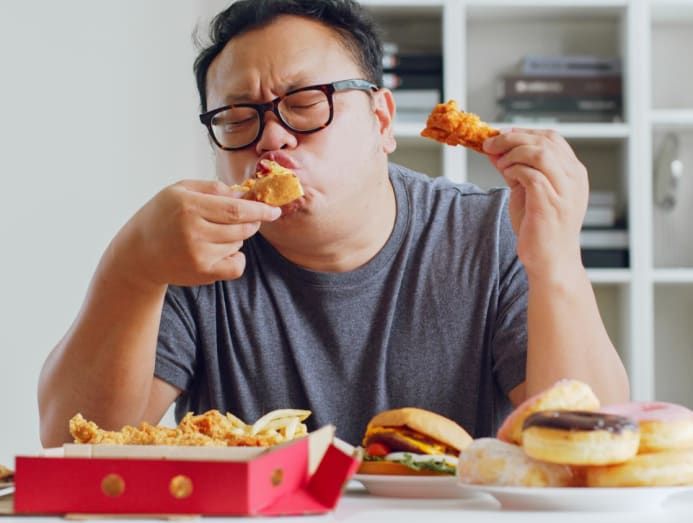
We use the word “binge” so casually that we sometimes forget that binge eating is actually a form of eating disorder. “It needs to be differentiated from overeating,” said Dr Melvin Look, the director of PanAsia Surgery in Mount Elizabeth Hospital, Mount Elizabeth Novena Hospital and Parkway East Hospital.
The difference: Binge eating involves compulsively eating a large amount of food in a short period, even when you’re not hungry.
“It is often an emotional response to some sort of stress or depression, and may be associated with guilt or disgust after the binge,” said Dr Look.
Over-eating, on the other hand, is “an act of mindlessness and lack of control”, like we sometimes do at a buffet, for instance.
If you tend to binge, taking smaller meals more frequently could be better for you. If you don’t binge, maybe skipping meals can help to reduce your overall caloric intake.
It is “harmless if it only occurs infrequently”, he said. Of course, overeating can become a problem, he warned, if it’s habitual and is combined with a lack of exercise.
To prevent overeating and ensure a balanced meal, here’s what Anthonysamy recommends putting together for your plate that’s around 500 to 600 calories:
- 1/2 piece of turkey thigh without skin
- 2 or 3 thin slices of roast beef
- Half plate of roasted vegetables with few potato cubes
- A few pieces of cut fruit
- 1 small piece of cake
SCENARIO #5: NIBBLING HERE AND THERE INSTEAD OF SITTING DOWN AT THE TABLE

It is okay to nibble as long as you do it consciously, said Reutens.
"Allow yourself a maximum of two servings per dish. Each serving is one spoon-full or ladle-full. Pick the dishes that are worth the extra calories for the second serving," she advised.
"Giving yourself the option to eat everything makes it less restrictive and you might end up not needing the second helping." If that doesn't curb your over-grazing, stick to five dishes, said Reutens.
SCENARIO #6: SKIPPING BREAKFAST AND LUNCH FOR THAT BIG DINNER
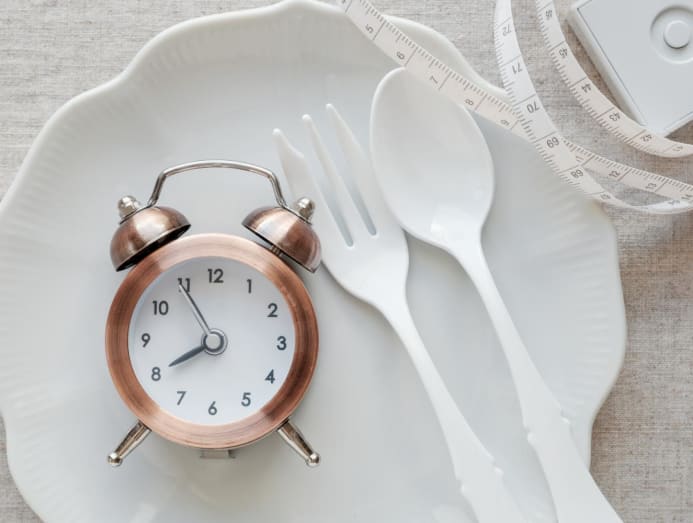
There are two schools of thought on this, said Dr Lan. Intermittent fasters will tell you that skipping a meal or two can let you use up your caloric stores and reduce the overall calories consumed in a day.
“But the downside to intermittent fasting is that it is not safe for everyone to do (for instance, diabetics on medication and people with gastritis symptoms).
Some people who skip meals may end up even hungrier when they finally eat, resulting in overeating and bingeing,” said Dr Lan.
Moreover, there are studies that have shown that eating more frequently throughout the day may decrease hunger and overall food intake, he added.
The best thing to do is to understand what your body does when you skip a meal, said Dr Lan. “If you tend to binge, taking smaller meals more frequently could be better for you. If you don’t binge, maybe skipping meals can help to reduce your overall caloric intake.”
Not sure how much alcohol (a standard drink) looks like in a glass? Practise measuring it out at home.
Christmas dinners tend to be high in carbohydrates and fat, so to balance out your day’s nutrients, Anthonysamy suggested eating more fibre and protein for breakfast and lunch, which will also keep you full without consuming too many calories. Pick from her list below:
- Garden salad with chicken breast/canned tuna in water/boiled egg and a tablespoon of mixed nuts. Use herbs and lemon juice instead of a salad dressing.
- Sweet potato with roasted vegetables and tofu
- Banana yoghurt smoothie with vegetables such as spinach leaves
- Chickpea salad with quinoa
- Vegetable soup with chicken/fish/egg
- Miso tofu soup with leafy vegetables
- A slice of wholemeal bread with a hard-boiled egg and a side salad
SCENARIO #7: DRINKING A LOT OF ALCOHOL

They say to drink in moderation but just how much alcohol is that? Anthonysamy cited the Health Promotion Board’s guidelines of two standard drinks a day for men; for women, that’s one standard drink a day.
“A standard drink contains 10g of alcohol and is equivalent to a 330ml can of regular beer, half a glass (100ml) of wine, or 30ml of hard liquor.”
Not sure how much alcohol that looks like in a glass? Practise measuring it out at home, said Anthonysamy. “You will be better at eyeballing a glass to determine the alcohol content when you’re out drinking.”
Admittedly, it can be difficult to track the number of drinks you’ve had, especially if you’re drinking a variety.
Dr Lan recommended using apps such as DrinkControl and DrinkCoach to help you out. “These apps let you set your goal for how much you want to restrict your alcohol intake, not just for one session but over a month as well.”
If you can, drink a non-alcoholic drink between each serving of alcohol, suggested Dr Lan, and choose a single serving instead of a larger one (for instance, a single shot over a double shot).
If you’re paying for the drinks, pay as you order instead of keeping an open tab. That way, you’ll feel the pinch and are acutely aware of how much you are drinking, he said.





